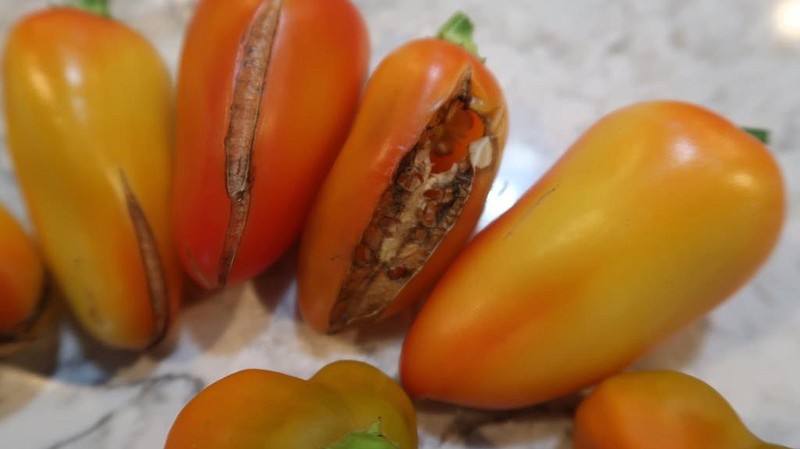Q Many of my peppers have big splits in them this week. Is there anything I can do to stop this? I have loads of new fruit coming on.
A Your peppers were simply overloaded with water last week and they split. This phenomenon occurs on tomatoes, peppers and even eggplant. We had too much water all at once. Cracking and splitting occur when rapid changes in soil moisture levels cause fruits to expand quicker than the tomato skin can grow. It usually affects the fruits that are nearing maturity. The peppers (and tomatoes and eggplant) are edible, if you harvest them quickly and use them. Otherwise, they begin to deteriorate rapidly and can rot on the vines.
Q Last spring a friend gave me a couple of "Celeste" fig cuttings. I put them in a pot with potting soil in a shady location and now they've really taken off. Should I transplant them now, or wait until after the first frost? Do I need to set them at their current depth, or bury them deeper, as you do tomato transplants? Any other advice will be appreciated. We live in Marianna, so they should do well in our yard (if I can keep squirrels, birds and raccoons away!).
A If you plan to plant them this year, and you can keep them watered, the sooner you plant, the better. It will allow the root system to start getting established before cold weather hits. Figs can suffer winter damage in a cold winter, even when they are well-established. Another option would be to keep them in their pots, move them to a protected spot for the winter, then plant them in the ground in the spring. Full morning sun and afternoon shade can help with winter hardiness. Plants in full afternoon sun go through more ups and downs with temperatures than those that are in some shade in the afternoon. When you do plant, you want to plant them at the same depth they are growing in now. Tomatoes are one of the few plants that can be buried deeper without problems.
Q How do I get a bushier "Black and Blue" salvia shrub starting next spring when the salvia comes out of dormancy? I can read a newspaper through them. What fertilizer would ensure a healthy start? Do I pinch back all new growth? The hummingbirds love this plant.

A I have to admit that is one of the leggiest, but tallest "Black and Blue" salvia I have seen. It normally will reach a height of 3-4 feet. After a killing frost, cut the plant back to the soil line and add a fresh layer of mulch. When new growth begins next spring, fertilize with a complete fertilizer. Normally they start blooming in early summer and continue until frost. If it starts to get spindly midseason, give it a haircut and it should bush out. Deadheading the spent blooms will also keep it blooming well. It does best in full sun but needs only a minimum of six hours of sunlight to bloom well.
Q Will you identify this for me, please? I potted it as a tiny thing thinking it might be a Japanese maple. Now I think it's a weed I should destroy.

A I believe your seedling is a sumac. It is one of the standard forms, so it can grow quite large, and it also can spread. You could try growing it in a large container to limit its root spread. Sumacs have one of the prettiest fall color displays. There are some excellent new landscape varieties.
Q My wife and I have been nurturing and watering this plant because we thought it may have been something we planted. We now suspect it to be a "coocoo's egg" type invader pushing out the flowers we do know. What is it?

A I believe the plant is Boneset (Eupatorium perfoliatum). It is a native perennial plant that blooms in late summer and early fall. It can colonize fairly quickly. It was a common herb used in folk medicine.
Retired after 38 years with the University of Arkansas Cooperative Extension Service, Janet Carson ranks among Arkansas' best known horticulture experts. Her blog is at arkansasonline.com/planitjanet. Write to her at P.O. Box 2221, Little Rock, AR 72203 or email

